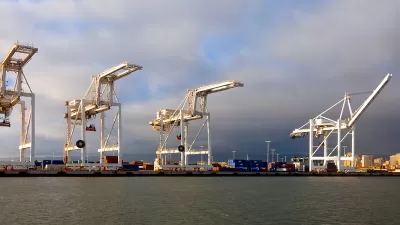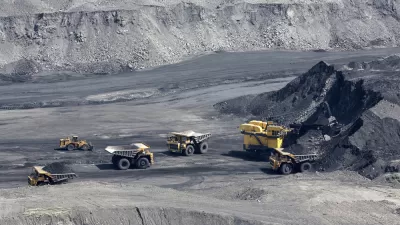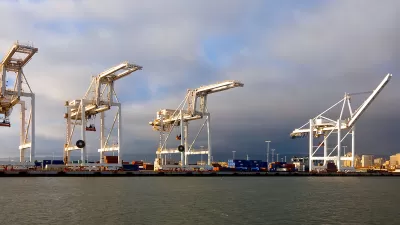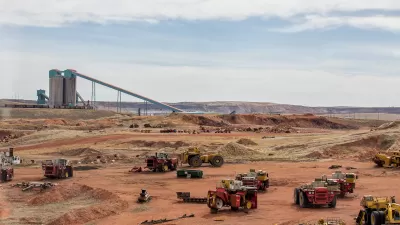Shipping coal from Utah to export to Asia through a new cargo facility in Oakland, California took a significant step forward on May 15 with a strongly worded ruling condemning the adequacy of the city of Oakland's environmental analysis.

"U.S. District Court Judge Vince Chhabria said in a sometimes harshly worded 37-page ruling [pdf] issued Tuesday that while the City Council was justified in taking steps to protect the health of residents, it lacked 'substantial evidence' that planned coal shipments through the yet-to-be-built Oakland Bulk and Oversize Terminal would pose a substantial health or safety danger," reports Dan Brekke for KQED News, the Bay Area's major NPR-member station.
The judge's ruling in the court case, titled "Oakland Bulk & Oversized Terminal, LLC v. City of Oakland", is that the city, by enacting the coal ban, had violated its contract with the developer of the new terminal, Phil Tagami.
The ruling is the latest chapter in a dispute that began with the city's attempt to find a developer for a parcel from the old [1,800-acre] Oakland Army Base just south of the Bay Bridge Toll Plaza.
Tagami's Oakland Bulk and Oversize Terminal concern won the right in 2012 to develop the property as a bulk cargo facility -- one that would handle uncontainerized materials like grain, timber, cement or minerals like coal. The project is separate from the Port of Oakland.
The ruling is not based on whether the city has the right to ban coal shipments but on the environmental analysis, prepared by Bay Area-based Environmental Science Associates, that lays the basis for the ban. Judge Chhabria blasted it as "riddled with inaccuracies, major evidentiary gaps, erroneous assumptions, and faulty analyses, to the point that no reliable conclusion about health or safety dangers could be drawn from it."
The judge cited a wide range of what he described as shortcomings in the report and other evidence considered by the city in enacting the coal ban.
"The city was not required to compile a perfect evidentiary record; far from it," Chhabria wrote. "But the gaps and errors in this record are so numerous and serious that they render it virtually useless. [See treatment of coal dust cited as example below].
Environmental justice setback
A July 2016 post describes the unanimous vote by the city council "in favor of an ordinance banning the handling and storage of coal in the city," viewed as an environmental justice issue affecting West Oakland, "among the poorest and most polluted neighborhoods in the region."
"The Northern Alameda County branch of the Sierra Club's Bay Area chapter, one of the environmental and public health groups that had pushed for the coal ban, said it expects the legal fight over planned coal shipments to the facility to continue," adds Brekke.
“Despite this unfortunate setback, we believe the city of Oakland has every right to protect the public health of its community, especially for the most vulnerable, by banning the handling and storage of coal at the Oakland Army Base," Luis Amezcua, chair of the branch, said in a statement.
[Oakland] Mayor Libby Schaaf and environmental groups that supported the ban expressed disappointment at the ruling. The city said it may appeal the decision.
Appeal ill-advised
That would be a "waste of money," David Levine, professor emeritus at UC Hastings College of the Law, tells KQED's Tara Siler in the audio tape accompanying the article. "It will be a very difficult opinion to overturn."
“You hardly see an opinion that is so one-sided,” said Levine, after reading Chhabria's ruling.
"The judge goes in chapter and verse explaining what was wrong, and you could hardly make more mistakes, it looks like, than what was done here," Levine said.
He adds that "the door is open a bit" to an appeal, based on the San Francisco Baykeeper's managing attorney interpretation of the ruling, but believes it would be more productive if the city were to work with Tagami to develop mitigations.
Coal dust mitigations cited as an example of shoddy analysis
"[T]he judge said the study failed to assess steps the terminal developers have promised to take to limit the spread of coal dust. One of those measures involves fitting coal cars with covers, a technique that hasn't been used in the United States," writes Brekke.
"Unable to find additional information about how well these covers would work for coal cars, ESA simply assumed they would not be used," Chhabria wrote. "This was a big mistake. The lack of existing data about the effectiveness of a new technology like rail car covers is not enough of a reason to assume them away, particularly when the developers have committed to using them."
According to an October 2016 Think Progress article, "coal trains can’t be covered, due to the combustible nature of coal, which means that as these trains rumble through communities, and near rivers, they can spew coal dust into the air and, potentially, into bodies of water."
A study prepared by Human Impact Partners on the Oakland coal transport project reinforces that finding and describes the damage to public health by coal dust. However, it also appears to be the study cited by Judge Chhabria for its inadequacy:
- Use of covers for coal cars has been asserted to prevent emissions of coal dust, but this approach is largely experimental and has not been demonstrated in the field to be safe, reliable or effective. Since the panel could find no evidence that covers for coal train cars are currently in use in the U.S., it is impossible to vouch for their safety regarding the possibility of combustion due to the confinement of coal.
FULL STORY: Federal Judge Throws Out Oakland's Ban on Coal Shipments Through Planned Terminal

Alabama: Trump Terminates Settlements for Black Communities Harmed By Raw Sewage
Trump deemed the landmark civil rights agreement “illegal DEI and environmental justice policy.”

Study: Maui’s Plan to Convert Vacation Rentals to Long-Term Housing Could Cause Nearly $1 Billion Economic Loss
The plan would reduce visitor accommodation by 25% resulting in 1,900 jobs lost.

Planetizen Federal Action Tracker
A weekly monitor of how Trump’s orders and actions are impacting planners and planning in America.

Grand Rapids Mayor Proposes Garage Conversion Plan
The mayor says allowing homeowners to convert garages to dwelling units could alleviate the city’s housing shortage.

Baltimore Ordered to Improve Sidewalk Accessibility
The city is one of many to face lawsuits for failing to comply with the Americans with Disabilities Act.

This Toronto Suburb Has More Bus Riders Than Columbus, Ohio
Brampton, Ontario used gradual improvements in service to prove that if you build it, they will ride.
Urban Design for Planners 1: Software Tools
This six-course series explores essential urban design concepts using open source software and equips planners with the tools they need to participate fully in the urban design process.
Planning for Universal Design
Learn the tools for implementing Universal Design in planning regulations.
Smith Gee Studio
Alamo Area Metropolitan Planning Organization
City of Santa Clarita
Institute for Housing and Urban Development Studies (IHS)
City of Grandview
Harvard GSD Executive Education
Toledo-Lucas County Plan Commissions
Salt Lake City
NYU Wagner Graduate School of Public Service





























